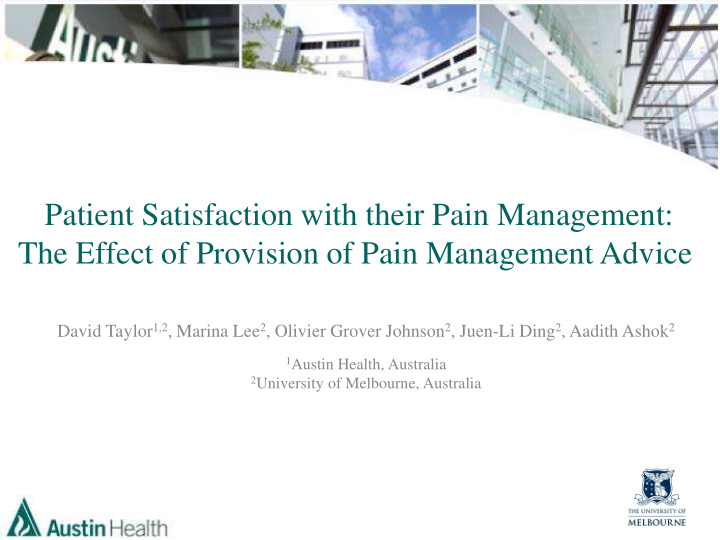



Patient Satisfaction with their Pain Management: The Effect of Provision of Pain Management Advice David Taylor 1,2 , Marina Lee 2 , Olivier Grover Johnson 2 , Juen-Li Ding 2 , Aadith Ashok 2 1 Austin Health, Australia 2 University of Melbourne, Australia
Background • Pain is the most common presenting complaint in the ED • Inadequate use of analgesics is widely recognized • Initiatives: • staff training • time-to-analgesia KPIs • nurse-initiated analgesia • mandatory recording of triage pain scores • Goal is a high level of patient satisfaction with pain management
Background • The provision of ‘pain advice’ is associated with high levels of patient satisfaction with their pain management 1-3 • Definition: ‘The treatment of pain is very important and be sure to tell the staff when you have pain’ • ‘Pain advice’ as an intervention? • Aim: To provide ‘pain advice’ as an intervention and evaluate its impact upon patient satisfaction 1. Jao K et al. Emerg Med Australas 2011;23:195-201 2. Shill J et al. Acad Emerg Med 2012;19:1212-1215 3. Taylor DMcD et al. Emerg Med Australas In press
Methods • Pilot, randomized, controlled, clinical intervention trial • Austin Hospital ED, tertiary referral, 80,000 patients/year • February-May, 2015 • Approved by the Austin Health HREC • Registered Australian New Zealand Clinical Trials Registry
Methods Inclusion criteria: • age 18 years or more • moderate- severe pain (pain score ≥4, VNRS 0 -10) Exclusion criteria: • triage category 1 • suspected cardiac chest pain • too ill to approach • unable to communicate adequately • no means for follow up (e.g. no telephone) • declined participation in the follow up interview
Methods • Convenience sampling (08:00-18:00, weekdays) • Consecutive patients meeting entrance criteria enrolled • Computer generated randomization to: • Control arm: standard care • Intervention arm: standard care + ‘pain advice’ (from investigator) • Blinding: • Patients and ED staff: undertaking of the study and patient enrolment • ED staff: ‘pain advice’ provision • Investigator collecting outcome measures at follow up
Methods • Control group patients were not approached • Intervention patients given ‘pain advice’ once by an investigator • ‘The ED staff consider pain treatment is very important so be sure to tell the ED nurse when you have pain’ • No other intervention • Prospective data collection while the patient in the ED
Methods • Follow up data 48 hours post-discharge • An investigator blinded to the patients’ randomization status “During your stay [in the ED], was it made clear to you that the staff consider treatment of pain very important and that you should be sure to tell them when you have pain?” (yes, no) “During your stay, how frequently were you asked to score your pain?” (not at all, infrequently, frequently, very frequently) “How satisfied or dissatisfied are you with the results of your pain treatment [in the ED], overall?” (6 point ordinal scale: very dissatisfied-very satisfied)
Methods Primary Outcome: • level of patient satisfaction with their pain management (% proportion of patients who were ‘very satisfied’) Secondary Outcomes: • % patients who reported having been given pain advice • the perceived frequency of pain score measurement (actual frequency not known)
Methods Sample size: Recall having received ‘pain advice’ • -control arm 80% -intervention arm 90% 400 patients, power 0.76 (2-sided, alpha 0.05) • Analysis: Chi square test for comparison of proportions • SPSS (Version 22.0, SPSS Inc., Chicago, Illinois, USA) •
Results Patients screened for enrolment (n=588) Excluded (n=33): -poor English (n=20) -cognitive disorder (n=3) -no telephone (n=5) -significant illness (n=5) Patients randomised (n=555) Excluded (n=60): Excluded (n=84): -Uncontactable (n=53) -Uncontactable (n=77) -Declined interview (n=7) -Declined interview (n=7) Standard Care Arm Intervention arm Patients analysed Patients analysed (n=196) (n=215)
Results The baseline characteristics of the two study arms did not differ (p>0.05): Age • Gender • Ethnicity • Triage category • Triage pain score • Indication for analgesia • Nurse-initiated analgesia administration • Administered any analgesia • Administered simple analgesia • Administered oral opioid • Administered parenteral opioid •
Results standard care arm intervention arm n=196 n=215 variable n (%) n (%) p Pain advice received 152 (77.6) 191 (88.8) <0.01 Very satisfied with pain management 87 (44.4) 109 (50.7) 0.20 Pain score frequency not at all 33 (16.8) 18 (8.4) 0.05 infrequently 68 (34.7) 86 (40.0) frequently 80 (40.8) 87 (40.5) very frequently 15 (7.7) 24 (11.2)
Results Variables associated with patient satisfaction with pain management (patients in both arms pooled) not very satisfied very satisfied n=215 n=196 variable n (%) n (%) p Pain advice received 164 (76.3) 179 (91.3) <0.001 Pain score frequency not at all 37 (17.2) 14 (7.1) <0.01 infrequently 85 (39.5) 69 (35.2) frequently 76 (35.3) 91 (46.4) very frequently 17 (7.9) 22 (11.2)
Conclusion • An intervention to provide ‘pain advice’ results in a clinically significant increase in patient satisfaction • effect size will inform the design of a larger study • better effect if the ED staff provide ‘pain advice’? • Significant positive association between the perceived frequency of pain score measurement and patient satisfaction • consider another RCT: standard care versus standard care + regular pain scoring
Recommend
More recommend